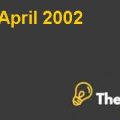
Introduction
All the managers of today’s era have started to place a lot of importance on the performance of the firms after the impact of measures on it. However, there are very few managers that think about these measures as a core component about the strategy of the corporation. For example, most of the today’s managers introduce new innovative operating business process and also new strategies in order to achieve high performance in their respective industries.
They then continue to use the same small indicators of assessing the financial performance of the companies and these indicators are for the short term only but the managers use them as the long term indicators of the financial performance of the companies. These short term indicators include return on investment, operating income growth and the growth in the sales. However, all such managers fail to incorporate new measures which also measure the new processes and the goals of the organizations. Not only this, but these managers also fail to question the old short term measures that they have been using since the beginning which might not be relevant at all to the new initiatives.
Therefore, the management process of an organization will only be considered as effective when effective measurement of all the goals and the processes in the organization becomes an integral part of the management planning. The balanced scorecard which was proposed for the first time in the year 1992, is one of the most simplified and a comprehensive framework that could be used by the executives and it could be used to transform the strategic objectives of the corporations into measureable performance measures in order to assess the impact the impact of different firm resources, activities, strategies and processes over the performance of the firm. The balanced scorecard is more than a simple tool for assessing the financial performance of the company, it could be used to highlight improvements into the most critical areas of the organization that are the customer, process, products and market development.
There are four different perspectives that are depicted by the balanced scorecard. These four perspectives are the innovation, internal process, customers and the improvement activities. These performance measures differ significantly from all the measures that were used by the managers historically. The measures that are presented by the balanced scorecard reflect the competitive demands and the strategic objectives of the organizations. The managers of the corporations focus on a limited set of measures under each of the four perspectives and this helped them to keep track of the business performance in the light of the strategic vision of the organization.
Furthermore, the other significant benefit of using a balanced scorecard is that it acts as a cornerstone to assess the current and the future performance of the company. The balanced scorecard also provides a balance between the internal measures as well as the external measures of the organization such as between the operating income and the development of new products. The balanced scorecard serves as the focal point in aligning the financial and non financial indicators of the corporations.Research Accounting Case Solution
Literature Review
When the balanced scorecard approach was introduced in the year 1992 by Kaplan and Norton, most of the managers were already looking for newer measurement systems in order to use for the budgetary controls and that would also replace the old accounting systems that were being used by the companies. The main objective of the balanced scorecard approach was to put light over the non-financial measures of an organization such as the operational processes and customer satisfaction. It is the best integrated tool which combines and transforms all the set of the outcomes and the activities into the broader strategic goals of the firm from an individual level.
This was the core need of the organizations that was gaining popularity with the passage of time and the balanced scorecard was the ultimate response to this need (Kaplan and Norton 1992). The balanced scorecard had incorporated both the financial measures along with the indicators of the non-financial performance of the company (Brown, 2000). Art Schneider man was the one who had coined the term of balanced scorecard in the year 1987. During the initial phase of the year 1990, the balanced scorecard was only seen as a set of financial and non-financial measures that consisted of about 15-20 numbers which were grouped into four perspectives. However, it was after that period that Kaplan and Norton had published many reports for the successful implementations of the balanced scorecard approach...................
This is just a sample partial case solution. Please place the order on the website to order your own originally done case solution.













